Key takeaways
- Inclusive lesson plans go beyond diverse materials; they create engaging experiences that validate every student’s unique background and needs.
- Classrooms that embrace diversity foster empathy, respect, and a sense of belonging, which are essential for personal and academic growth.
- Key principles of inclusive planning include seeking out missing voices, prioritizing adaptability, and engaging in ongoing reflection to address barriers to inclusion.
- Practical steps for inclusivity involve incorporating student feedback, offering diverse engagement methods, and creating a supportive community among educators.
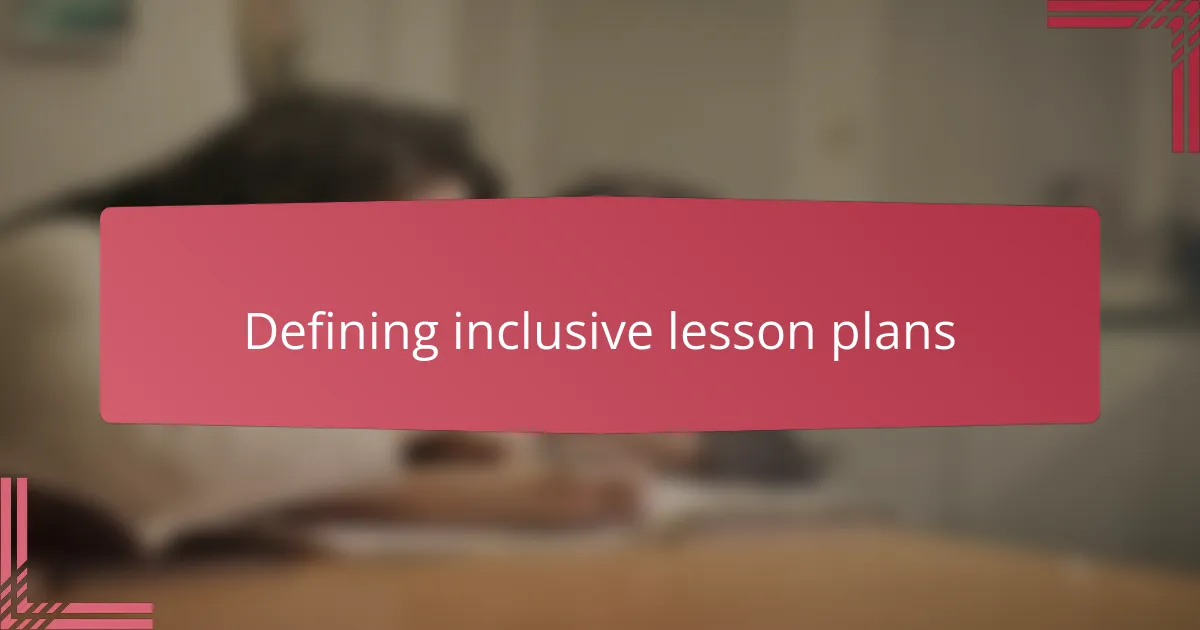
Defining inclusive lesson plans
Inclusive lesson plans, to me, are more than just a checklist of diverse materials; they are carefully crafted experiences that welcome every student’s unique background and needs. I remember designing a lesson once where I realized that by simply including examples relevant to my students’ cultures, I saw their engagement soar—it was a powerful reminder of how inclusion isn’t just a concept, but a lived experience in the classroom.
But what does it really mean for a lesson to be inclusive? Is it about adding more perspectives, or is it about fundamentally rethinking how we present information so that no one feels left out? Personally, I believe it’s both. It’s about creating pathways where every voice can be heard and every learner feels valued.
At its core, an inclusive lesson plan is flexible and responsive—it anticipates diverse learning styles, abilities, and identities. I’ve found that embracing this mindset transforms teaching from a one-size-fits-all approach into an opportunity for genuine connection and growth, both for my students and myself.
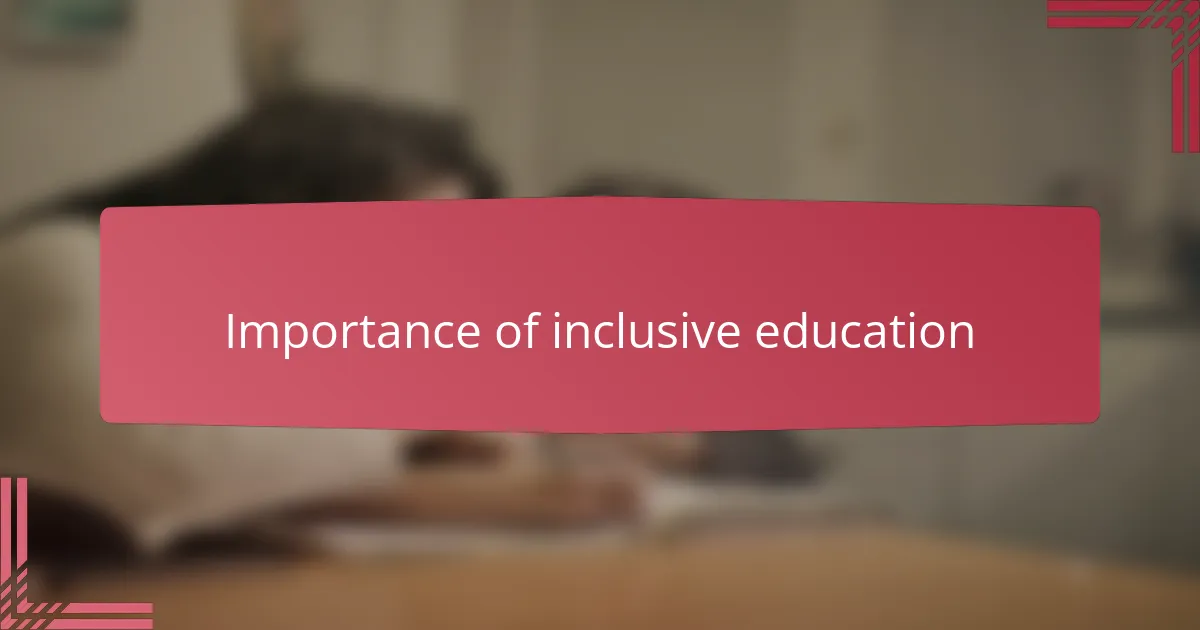
Importance of inclusive education
Inclusive education matters because it shapes how students see themselves and others. When every child feels recognized and valued, their confidence grows in ways that textbooks alone can’t achieve. I’ve watched shy students light up simply because their experiences were reflected back to them in lessons—it’s a powerful reminder that inclusion can unlock potential we might otherwise miss.
Have you ever noticed how a classroom that embraces diversity feels different? It’s more vibrant, dynamic, and alive. That energy comes from students feeling they belong, which fosters empathy and respect among peers—qualities that aren’t just good for school but essential for life beyond the classroom walls.
In my experience, inclusive education is also a form of justice. It challenges the barriers that often hold students back, whether those are based on language, ability, or background. Isn’t it our responsibility as educators to level the playing field so that every learner has the chance to thrive? I believe the answer is yes—and that conviction drives my commitment every day.
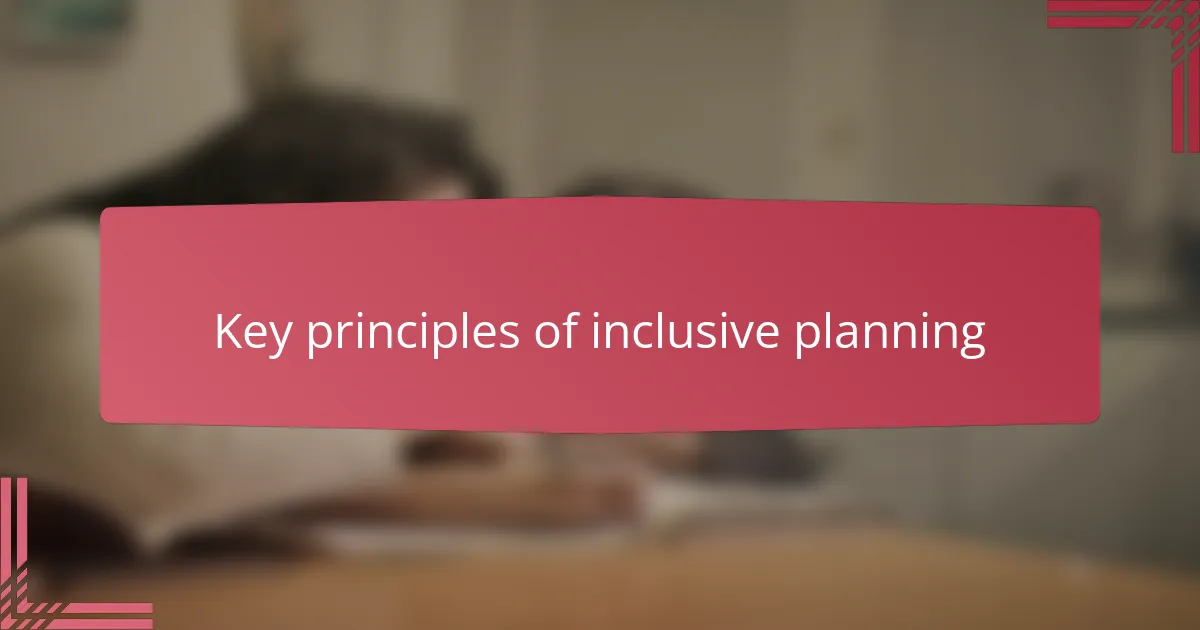
Key principles of inclusive planning
When I plan lessons inclusively, I always start by asking myself: Whose voices are missing here? This simple question shifts my focus—it pushes me to seek out resources and examples that reflect all my students’ identities, not just the dominant culture. Over time, I’ve learned that intentionally diversifying content isn’t tokenism; it’s about showing students they matter.
Another principle I hold close is adaptability. No two classrooms are the same, and a rigid plan can unintentionally exclude. I remember a time when I had to pivot a lesson on the spot because a student’s learning need wasn’t accounted for. That moment taught me the value of building flexibility into my plans so every student can access the material in ways that work for them.
Lastly, I believe inclusive planning requires ongoing reflection. After each lesson, I ask myself: Did everyone feel included? What barriers might still exist? This honest self-check isn’t always comfortable, but it’s necessary. From my experience, this process of continuous adjustment turns good intentions into meaningful change in the classroom.
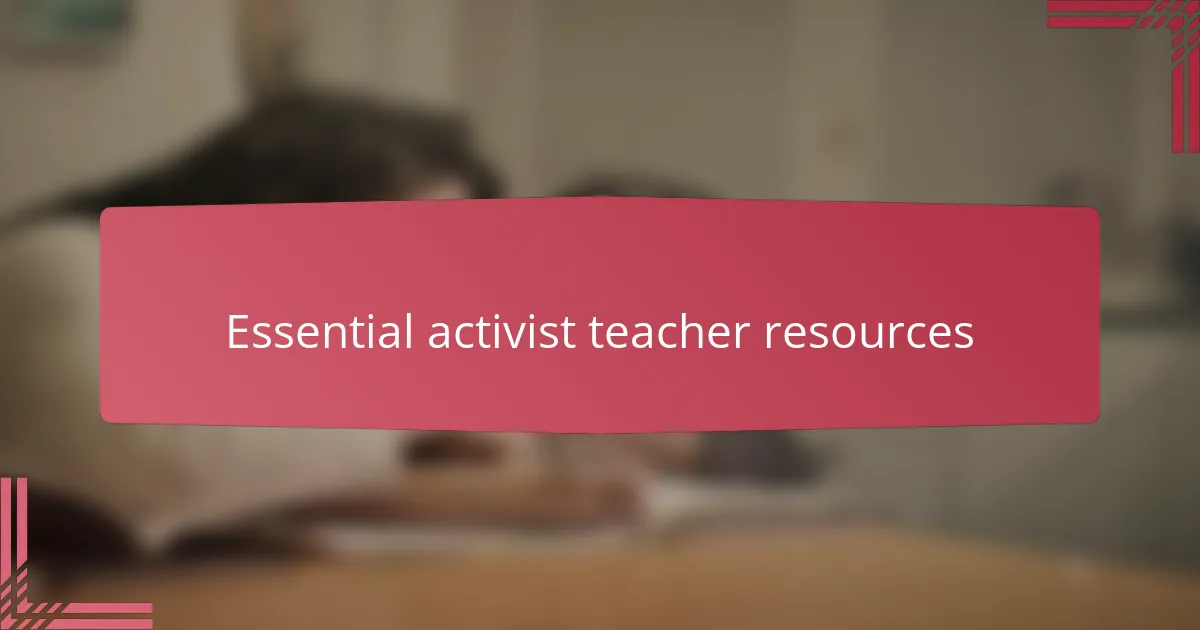
Essential activist teacher resources
When I first started integrating activist resources into my lesson planning, I quickly realized how crucial it is to have materials that truly resonate with social justice themes. It’s not enough to just sprinkle in a few texts or videos—I need tools that help me challenge systemic inequities right alongside my students. Have you ever felt stuck looking for resources that both educate and empower? That struggle led me to seek out activist teacher networks and repositories filled with adaptable, authentic content.
One resource that transformed my teaching was a curated collection of primary sources from diverse movements—these brought history to life and sparked conversations I hadn’t seen before. I remember a moment when a student exclaimed, “I didn’t know people like me made history!” That reaction reaffirmed how essential it is to find materials that connect personally and politically. For me, activist teacher resources aren’t just content; they’re a bridge to empathy and action.
I also want to emphasize the importance of community—a space where educators can share experiences, lesson ideas, and challenges openly. Without this support, creating inclusive lessons can become overwhelming. Reflecting on my own journey, engaging with fellow activist educators helped me grow and stay motivated. Isn’t teaching activism alone too hard? Building that collegial network made all the difference for me.
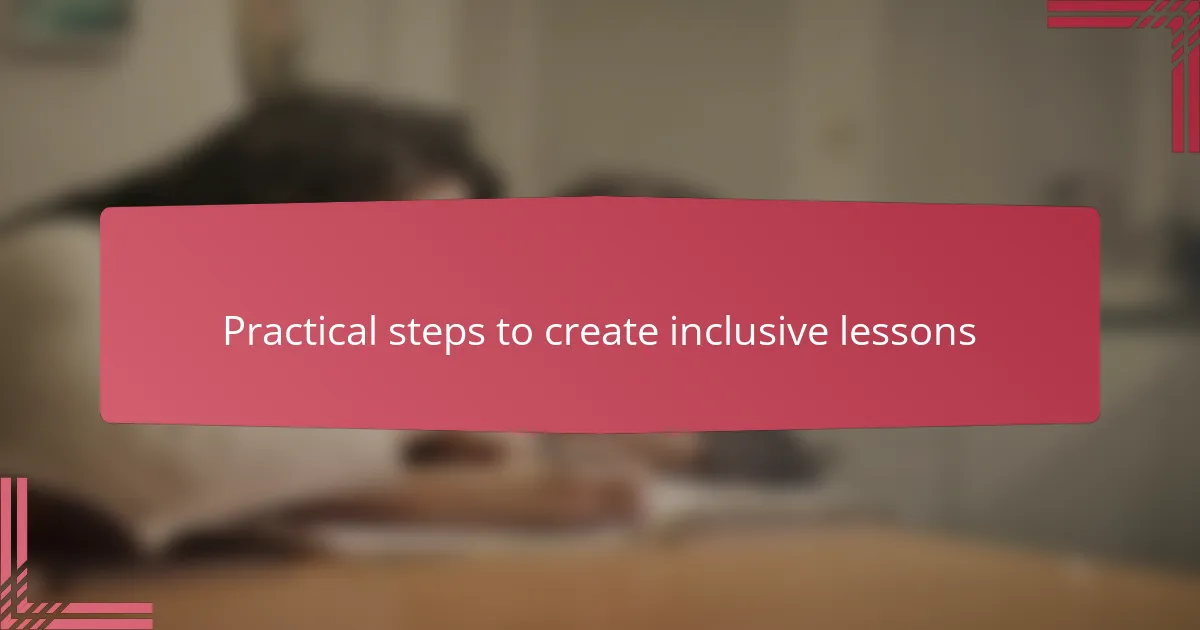
Practical steps to create inclusive lessons
One practical step I always take is starting with student voices—literally asking them what interests and challenges they have. This simple act helps me tailor lessons that resonate because the content feels relevant, not just another assignment. Have you ever noticed how students light up when they see their own stories reflected in discussions? That connection is everything.
Another move I’ve found effective is offering multiple ways to engage with material—videos, readings, hands-on projects—because not everyone learns the same way. Once, I replaced a text-heavy activity with an interactive simulation, and suddenly the classroom buzzed with energy. Flexibility isn’t just a buzzword; it’s a lifeline that lets every learner find their path.
Finally, I make room for ongoing feedback from students about what’s working and what isn’t. It can be uncomfortable to admit a lesson fell flat, but I’ve learned those moments are where growth happens. After all, isn’t the goal to create a space where every student feels seen and supported? For me, that commitment turns good intentions into real, inclusive learning experiences.
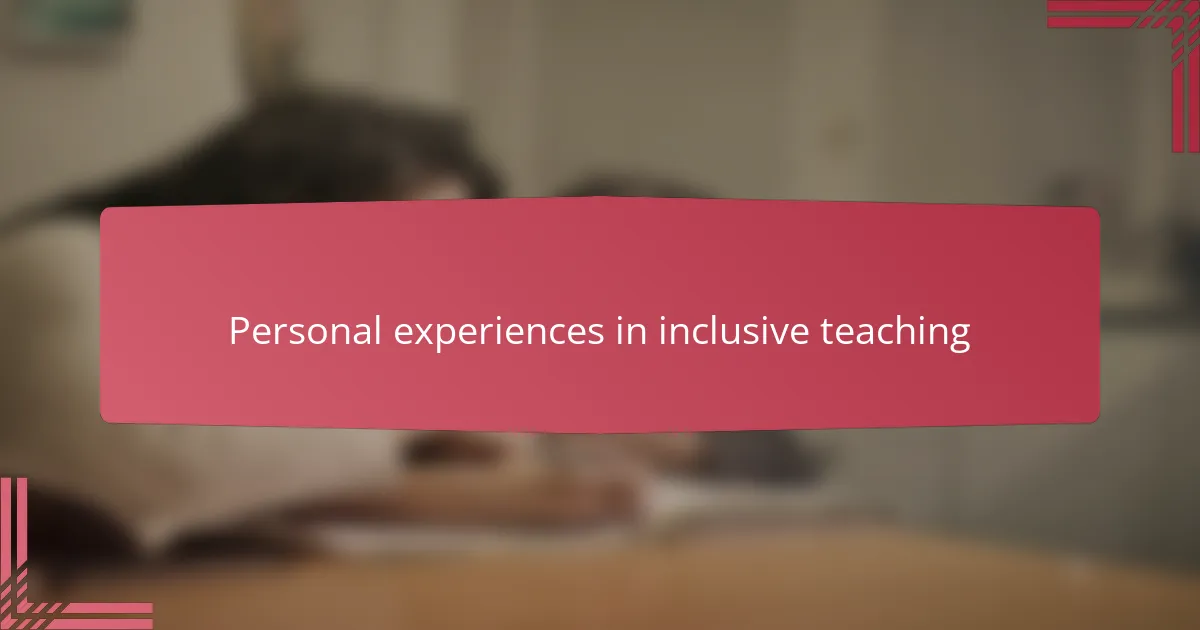
Personal experiences in inclusive teaching
In my early years of teaching, I vividly recall a student who struggled quietly, often fading into the background during lessons that didn’t reflect his experience. When I finally adapted my approach to include more visual and hands-on activities, tailored to different learning needs, his participation increased noticeably. That moment made me realize how small changes in lesson planning can significantly impact a student’s confidence and sense of belonging.
Have you ever felt the challenge of balancing diverse needs in a single lesson? I know I have, and it’s not always easy. Yet, those challenges have taught me that truly inclusive teaching demands ongoing patience and creativity—it’s about continually listening to students and being willing to adjust, rather than sticking rigidly to a plan.
There was also a time when I invited students to share their own cultural stories as part of a lesson. The atmosphere shifted palpably; students weren’t just absorbing content but contributing their lived experiences. That exchange didn’t just enrich the lesson—it deepened empathy and connection, showing me that inclusion thrives when we invite all voices to the table.